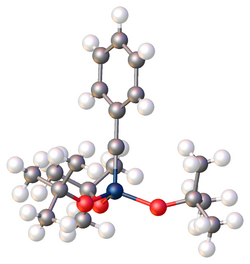Chemistry:Transition metal carbyne complex
Transition metal carbyne complexes are organometallic compounds with a triple bond between carbon and the transition metal.[1] This triple bond consists of a σ-bond and two π-bonds.[2] The HOMO of the carbyne ligand interacts with the LUMO of the metal to create the σ-bond. The two π-bonds are formed when the two HOMO orbitals of the metal back-donate to the LUMO of the carbyne. They are also called metal alkylidynes—the carbon is a carbyne ligand. Such compounds are useful in organic synthesis of alkynes and nitriles. They have been the focus on much fundamental research.[3]
Synthesis
Transition metal carbyne complexes are most common for the early transition metals, especially niobium, tantalum, molybdenum, tungsten, and rhenium. They can also have low-valence metals as well as high-valence metals.
The first Fischer carbyne complex was reported in 1973.[4] Two years later in 1975, the first "Schrock carbyne" was reported.[5]
Many high-valent carbyne complexes have since been prepared, often by dehydrohalogenation of carbene complexes. Alternatively, amino-substituted carbyne ligands sometimes form upon protonation of electron-rich isonitrile complexes. Similarly, O-protonation of μ3-CO ligands in clusters gives hydroxycarbyne complexes. Vinyl ligands have been shown to rearrange into carbyne ligands. Addition of electrophiles to vinylidene ligands also affords carbyne complexes.[3]
Bridging alkylidyne ligands in cluster compounds

Some metal carbynes dimerize to give dimetallacyclobutadienes. In these complexes, the carbyne ligand serves as a bridging ligand.
Several cluster-bound carbyne complexes are known, typically with CO ligands. These compounds do not feature MC triple bonds; instead the carbyne carbon is tetrahedral. Tricobalt derivatives are prepared by treating cobalt carbonyl with haloforms:[6]
- 2 HCBr3 + 9⁄2 Co2(CO)8 → 2 HCCo3(CO)9 + 18 CO + 3 CoBr2
Structure

Monomeric metal carbyne complexes exhibit fairly linear M–C–R linkages according to X-ray crystallography. The M–C distances are typically shorter than the M–C bonds found in metal carbenes. The bond angle is generally between 170° and 180°[8] Analogous to Fischer and Schrock carbenes; Fischer and Schrock carbynes are also known. Fischer carbynes usually have lower oxidation state metals and the ligands are π-accepting/electron-withdrawing ligands. Schrock carbynes on the other hand typically have higher oxidation state metals and electron-donating/anionic ligands. In a Fischer carbyne the C-carbyne exhibits electrophilic behavior while Schrock carbynes display nucleophilic reactivity on the carbyne carbon[9] Carbyne complexes have also been characterized by many methods including infrared Spectroscopy, Raman spectroscopy.[10] Bond lengths, bond angles and structures can be inferred from these and other analytical techniques.
Metal carbyne complexes also exhibit a large trans effect, where the ligand opposite the carbyne is typically labile.
Reactions and applications
Hexa(tert-butoxy)ditungsten(III) is a catalyst for alkyne metathesis.[11] The catalytic cycle involves an carbyne intermediate.[12]
Some carbyne complexes react with electrophiles at C-carbyne followed by association of the anion. The net reaction gives a transition metal carbene complex:
- LnM≡CR + HX → Ln(X)M=CHR
These complexes can also undergo photochemical reactions.
In some carbyne complexes, coupling of the carbyne ligand to a carbonyl is observed. Protonation of the carbyne carbon and conversion of the carbyne ligand into a π-allyl.[13]
Main group analogue
A sulfur-based main group analog of a carbyne complex has been prepared by Seppalt and coworkers.[14] The compound, trifluoro(2,2,2-trifluoroethylidyne)-λ6-sulfurane, F3C–C≡SF3, prepared by dehydrofluorination of F3C–CH=SF4 or F3C–CH2–SF5, is an unstable gas that readily undergoes dimerization to form trans-(CF3)(SF3)C=C(CF3)(SF3) at above –50 °C.
Further reading
- Mayr, A.; Bastos, C. M. (1992). Coupling Reactions of Terminal Two-Faced π Ligands and Related Cleavage Reactions. Progress in Inorganic Chemistry. 40. 1–98. doi:10.1002/9780470166413.ch1. ISBN 9780470166413.
References
- ↑ Cui, Mingxu; Jia, Guochen (2022-07-20). "Organometallic Chemistry of Transition Metal Alkylidyne Complexes Centered at Metathesis Reactions" (in en). Journal of the American Chemical Society 144 (28): 12546–12566. doi:10.1021/jacs.2c01192. ISSN 0002-7863. PMID 35793547. https://pubs.acs.org/doi/10.1021/jacs.2c01192.
- ↑ Kim, Heesook P.; Angelici, Robert J. (1987). Transition Metal Complexes with Terminal Carbyne Ligands. Advances in Organometallic Chemistry. 27. 51–111. doi:10.1016/S0065-3055(08)60026-X. ISBN 9780120311279.
- ↑ 3.0 3.1 Elschenbroich, C. (2006). Organometallics. Weinheim: Wiley-VCH. ISBN 978-3-527-29390-2.
- ↑ Fischer, E. O.; Kreis, G.; Kreiter, C. G.; Muller, J.; Huttner, G.; Lorenz, H. (1973). "trans-Halogeno-alkyl(aryl)carbin-tetracarbonyl-Komplexe von Chrom, Molybdän und Wolfram–Ein neuer Verbindungstyp mit Übergangsmetall-Kohlenstoff-Dreifachbindung". Angew. Chem. 85 (14): 618–620. doi:10.1002/ange.19730851407. Bibcode: 1973AngCh..85..618F.
- ↑ Guggenberger, L. J.; Schrock, R. R. (1975). "Tantalum carbyne complex". J. Am. Chem. Soc. 97 (10): 2935. doi:10.1021/ja00843a072.
- ↑ Seyferth, Dietmar; Nestle, Mara O.; Hallgren, John S. (2007). "μ3 -Alkylidyne-Tris(Trigarbonylcobalt) Compounds: Organocobalt Cluster Complexes". Inorganic Syntheses. 20. 224 224–226]. doi:10.1002/9780470132517.ch52. ISBN 9780470132517.
- ↑ Cotton, F. Albert; Schwotzer, Willi; Shamshoum, Edwar S. (1985). "Further studies of the reactions of ditungsten hexa-t- butoxide with acetylenes. Isolation and characterization of WO(OCMe3)4(THF), W3(OCMe3)5(μ-O)(μ-CC3H7)O2 and W(CPh)(OCMe3)3". Journal of Organometallic Chemistry 296 (1–2): 55–68. doi:10.1016/0022-328X(85)80338-7.
- ↑ Spessard, Gary O.; Miessler, Gary L. (2015). Organometallic Chemistry (2nd ed.). Oxford University Press. pp. 439–449. ISBN 9780199342679.
- ↑ Crabtree, R. H. (2014). The Organometallic Chemistry of the Transition Metals (6th ed.). New York, NY: Wiley. pp. 290–315. ISBN 9781118138076.
- ↑ Kreißl, F. R. (5 December 2012). Transition Metal Carbyne Complexes. Springer. ISBN 9789401047289.
- ↑ Fürstner, Alois (2021-09-29). "The Ascent of Alkyne Metathesis to Strategy-Level Status" (in en). Journal of the American Chemical Society 143 (38): 15538–15555. doi:10.1021/jacs.1c08040. ISSN 0002-7863. PMID 34519486.
- ↑ Listemann, Mark L.; Schrock, Richard R. (1985). "Multiple metal carbon Bonds. 35. A General Route to tri-tert-Butoxytungsten Alkylidyne complexes. Scission of Acetylenes by Ditungsten Hexa-tert-butoxide". Organometallics 4: 74–83. doi:10.1021/om00120a014.
- ↑ Kingsbury, K. B.; Carter, J. D.; McElwee-White, L. (1990). "Formation of cyclopentenone upon photo-oxidation of the cyclopropyl (c-C3H5) carbyne complex [(η5-C5H5){P(OMe)3}(CO)W≡C(c-C3H5)]". J. Chem. Soc., Chem. Commun. 1990 (8): 624–625. doi:10.1039/C39900000624.
- ↑ Poetter, Brigitte; Seppelt, Konrad; Simon, Arndt; Peters, Eva Maria; Hettich, Bernhard (February 1985). "Trifluoroethylidynesulfur trifluoride, CF3C.tplbond.SF3, and its dimer" (in en). Journal of the American Chemical Society 107 (4): 980–985. doi:10.1021/ja00290a038. ISSN 0002-7863.
 |


